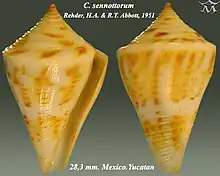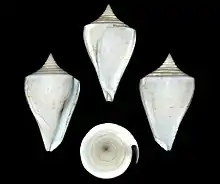Conus sennottorum
Conus sennottorum, common name Sennett's cone, is a species of sea snail, a marine gastropod mollusk in the family Conidae, the cone snails and their allies.[1]
| Conus sennottorum | |
|---|---|
 | |
| Apertural and abapertural views of shell of Conus sennottorum Rehder, H.A. & R.T. Abbott, 1951 | |
| Scientific classification | |
| Domain: | Eukaryota |
| Kingdom: | Animalia |
| Phylum: | Mollusca |
| Class: | Gastropoda |
| Subclass: | Caenogastropoda |
| Order: | Neogastropoda |
| Superfamily: | Conoidea |
| Family: | Conidae |
| Genus: | Conus |
| Species: | C. sennottorum |
| Binomial name | |
| Conus sennottorum Rehder & Abbott, 1951 | |
| Synonyms[1] | |
| |
Like all species within the genus Conus, these snails are predatory and venomous. They are capable of "stinging" humans, therefore live ones should be handled carefully or not at all.
Distribution
Locus typicus: "Off Campeche, Yucatan, Mexico."[2]
This species occurs in the Caribbean Sea and in the Gulf of Mexico., from West Florida to Venezuela.
Type material
"Holotype and paratypes in United States National Museum, Washington. Also paratypes in collection Sennott.
The holotype and one paratype were figured by Clench (1953: pl. 185, figs 1,2) and Abbott (1974: 255, fig. 2786)."[4]
References

Conus sennettorum, holotype at the Smithsonian Institution
- Conus sennottorum Rehder & Abbott, 1951. Retrieved through: World Register of Marine Species on 27 March 2010.
- Danker Vink, 1985, La Conchiglia 17, The Conidae of the W. Atlantic, Part V, page 14.
- Welch J. J. (2010). "The "Island Rule" and Deep-Sea Gastropods: Re-Examining the Evidence". PLoS ONE 5(1): e8776. doi:10.1371/journal.pone.0008776.
- Danker Vink, 1985, La Conchiglia 17, The Conidae of the W. Atlantic, Part V, page 14.
- Rehder, H. A. and R. T. Abbott. 1951. Some new and interesting mollusks from the deeper waters of the Gulf of Mexico. Revista de la Sociedad Malacológica "Carlos de la Torre" 8: 53–66, pls. 8–9.
- Tucker J.K. & Tenorio M.J. (2009) Systematic classification of Recent and fossil conoidean gastropods. Hackenheim: Conchbooks. 296 pp.
- Puillandre N., Duda T.F., Meyer C., Olivera B.M. & Bouchet P. (2015). One, four or 100 genera? A new classification of the cone snails. Journal of Molluscan Studies. 81: 1–23
External links
- The Conus Biodiversity website
- Cone Shells – Knights of the Sea
- "Gradiconus sennottorum". Gastropods.com. Retrieved 16 January 2019.
Wikimedia Commons has media related to Conus sennottorum.
This article is issued from Wikipedia. The text is licensed under Creative Commons - Attribution - Sharealike. Additional terms may apply for the media files.